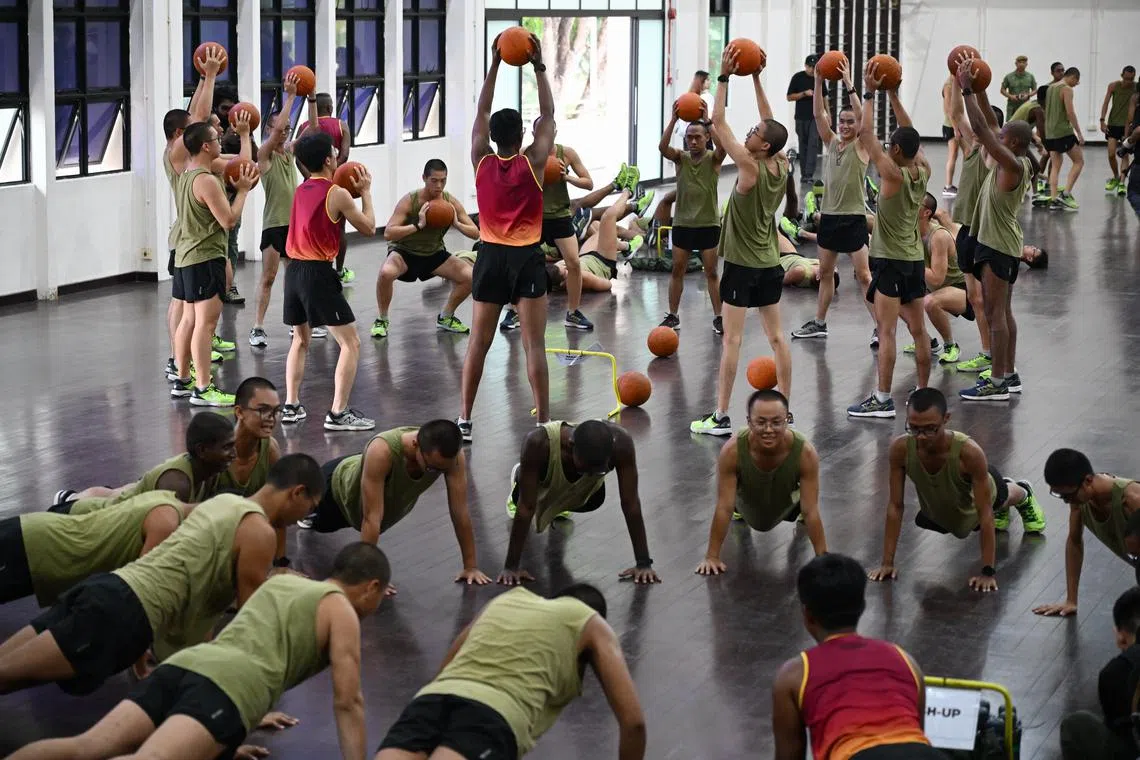All recruits at BMTC will be trained to fly drones and counter them: Chan Chun Sing
Sign up now: Get ST's newsletters delivered to your inbox
Follow topic:
- All BMTC recruits will be trained to use and combat drones.
- Soldiers will operate drones and other tech, multiplying SAF capabilities using technology.
- SAF personalises training using heart rate monitors and dedicated physiotherapy, optimising performance and faster recovery for soldiers.
AI generated
SINGAPORE – All recruits trained at the Basic Military Training Centre (BMTC) on Pulau Tekong will learn to use drone technology and how to counter it, said Defence Minister Chan Chun Sing on Aug 4.
Speaking to the media after his first visit to BMTC since taking over the defence portfolio in May, Mr Chan said unmanned technology is proliferating and the Singapore Armed Forces (SAF) needs to know how to use it and fight against it.
Given such developments, soldiers must now be trained to expand their situational awareness, he said.
Drone training is not just about tactical or technical skills, he added.
“It’s also a larger exercise to train (soldiers) in their three-dimensional spatial awareness because when they fight the battle, how they apply their weapon systems, they have to think three-dimensional, and not just two dimensions.”
The first group of over 3,000 soldiers to learn basic drone skills during basic military training (BMT) enlisted in July, and SAF is currently developing doctrine on how to evade drones.
SAF has always used technology to complement its fighting capabilities, Mr Chan said.
Speaking to the media after watching recruits operate a roughly palm-size drone outfield, he said that in the past, one soldier could be armed with just a rifle.
But now and in the future, a single soldier operates not just his own rifle, but also a suite of technologies, from drones to robots, that will augment his capabilities, he added.
“This is how the SAF will continue to multiply our capabilities using technology.”
The goal is to have all soldiers who pass through BMT trained in how to operate drones and counter against them, starting at the end of 2025 or beginning of 2026, said BMTC commander Muhammad Helmi Khaswan on the sidelines of the visit.
Drone training starts with a series of videos that recruits watch on their own, followed by simulations and flying the drones in an urban environment. Recruits then move on to use them in the field, he said.
SAF also wants to build a sense of comfort with drones and other unmanned systems, Colonel Helmi added.

Defence Minister Chan Chun Sing said unmanned technology is proliferating and the SAF needs to know how to use it and fight against it.
ST PHOTO: KUA CHEE SIONG
Recruit PR Udayakumar, 21, is one of this first batch of soldiers learning drone skills. He had no previous experience flying such devices but was able to pick it up relatively easily, he said.
He said: “Considering the current threats and current emerging issues, I think drones have been very helpful to solve issues without risking a man’s life.”
Training has evolved
Mr Chan also witnessed recruits doing physical training while fitted with heart rate monitors on their wrists to help track their exertion, as well as recruits undergoing physiotherapy at a dedicated centre to recover from injury.
The way soldiers are trained now is more personalised compared with in the past when training was done en masse, he said.
Mr Chan said: “When you do group training, you are training to the average of what that whole group of soldiers, or platoon of soldiers, is able to do.
“We are now able to personalise the training. We know each and every soldier’s heart rate, how much effort they are exerting, whether they can go further, or they are at risk of overstraining themselves.”

Recruits at the Basic Military Training Centre on Pulau Tekong on Aug 4.
ST PHOTO: KUA CHEE SIONG
All this allows SAF to be more intentional about how it optimises soldier performance – which it is able to do now because of past investments to apply science and data to training methods, Mr Chan said.
There is now a “much faster closing of the loop” in helping soldiers recover as well, he added.
He said: “So in the past, the way we let soldiers recover is very much on their own, but today, we are much more scientific, much more data-driven on how we allow the soldiers to condition themselves, to recuperate and to recover from any injury.”
This includes maintaining overall physical fitness while recovering from injuries to specific body parts, Mr Chan said.
This approach has wider implications for how SAF will make use of its finite manpower resources, because each and every soldier is important, he added.
He said: “The faster the soldier can recover, the more optimal his or her performance is, the better we are able to utilise our manpower resources.”
However, there are things about the armed forces that have not changed and must not change, he said.
Some of the very basics of fundamental soldiering skills continue to be emphasised, such as the ability to take care of themselves in a challenging environment.
Also important are the soldiers’ ability to work as a team to overcome challenges and how they bounce back from adversity.
Mr Chan said: “All these are important skill sets for any soldier across the SAF, and this is something that the SAF will continue to emphasise, how we build up the resilience and the will to fight for our soldiers.”


